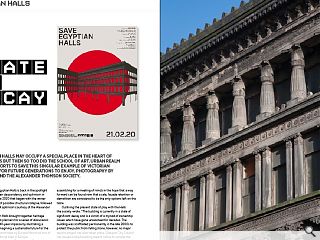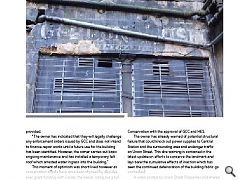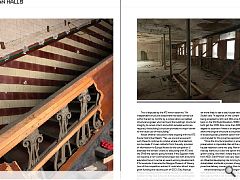Egyptian Halls: State of Decay
15 Apr 2020
The Egyptian Halls may occupy a special place in the heart of Glaswegians but then so too did the school of art. Urban Realm looks at efforts to save this singular example of victorian eclecticism for future generations to enjoy. Photography by Nick Hayes and the Alexander Thomson Society.
Glasgow’s A-listed Egyptian Halls is back in the spotlight having swung between despondency and optimism in a rollercoaster start to 2020 that began with the owner raising the prospect of possible structural collapse, followed by a renewed burst of optimism courtesy of the Alexander Thomson Society.
Save the Egyptian Halls brought together heritage bodies, architects and planners for a series of discussions designed to break a 40-year impasse by illustrating a variety of concepts imagining a sustainable future for the building after it was shortlisted by Europa Nostra as one of the 14 most at-risk cultural sites in Europe.
In attendance were Historic Environment Scotland (HES), the Glasgow Building Preservation Trust and the Society for the Protection of Ancient Buildings (SPAB) assembling for a meeting of minds in the hope that a way forward can be found now that a sale, façade retention or demolition are considered to be the only options left on the table.
Outlining the present state of play with the Halls the society wrote: “The building is currently in a state of significant decay and is a victim of a myriad of ownership issues which have gone unresolved for decades. The building was scaffolded permanently in the late 2000s to protect the public from falling stone, however, no major repairs project has ever taken place. Glasgow City Council has issued a listed building repairs notice to compel the owner to carry out repairs, including setting a deadline of July 2019 for a timetable to be presented to the council for works to be carried out - however, no such timetable was provided.
“The owner has indicated that they will legally challenge any enforcement orders issued by GCC and does not intend to finance repair works until a future use for the building has been identified. However, the owner carries out basic ongoing maintenance and has installed a temporary felt roof which arrested water ingress into the building.”
This moment of optimism was short-lived however as conservation efforts have since been stymied by disputes over grant funding, with Souter, the owner, ruling out a full restoration as economically unviable. In the prophetic words of Gavin Stamp, writing as Piloti in Private Eye at the time: “Would the agency (Scottish Enterprise) now help with the restoration of a commercial building by Mackintosh?
“… Are they hypocrites or fools – or are these flash executives just reflecting the modern Glasgow culture of loathing good architecture and old buildings?”
The on/off saga traces its roots back to a dispute over ownership, resolved following a compulsory purchase order in 2000 which left Dundonian developer Derek Souter as the lead owner of both ground and upper floors at a purported cost of £5.5m, presaging a full renovation plan drawn up by The Morrison Partnership and Addison Conservation with the approval of GCC and HES.
The owner has already warned of potential structural failure that could knock out power supplies to Central Station and the surrounding area and endanger traffic on Union Street. This dire warning is contained in the latest update on efforts to conserve the landmark and lays bare the cumulative effects of inaction which has seen the continued deterioration of the building fabric go unchecked.
A video posted by Union Street Properties and shared on Urban Realm warns of the ‘very real threat of structural collapse’ with an estimated 85% of the current structure needing to be replaced to stave off the potential failure of floor slabs, supports and beams. This, it was said, could precipitate the collapse of the roof and front façade through a loss of structural integrity and lateral restraint. A graphic demonstration of this ‘catastrophic’ risk is presented in the form of the façade collapsing onto Union Street together with secondary fears relating to the failure of parapet stonework which could present a fall hazard to pedestrians, despite the presence of supportive scaffolding which has been in place as a precautionary measure for the better part of a decade.
This is disputed by the ATS which observes: “An independent structural assessment has been carried out within the last six months by a conservation-accredited structural engineer who has found the buildings’ structural integrity to remain intact, and whilst remedial works are required, the building’s structure provides no major barrier to the future use of the building.”
Asked whether discussions were ongoing with the ATS Souter told Urban Realm: “Yes, we are and we expect/wish these to continue to a status where a final decision can be made. It’s been cathartic from the early provision of information for Europa Nostra to the competition (I attended the winners’ event) to discussing with ATS and the SPAB the options going forward. If the Egyptian Halls can become a non-commercial project but with a tourism/education focus it can be an award-winning development. If for example, it became the Glasgow Museum of Slavery (one of the competition entries) it could also attract major grant funding and become part of GCC’s City Avenues Project unlocking further funding sources. Or even a new location for the GSA School of Architecture (controversial for sure but who was the better architect not the most famous?)”
What’s the most likely outcome as Souter sees it? Are we more likely to see a sale, façade retention or demolition? Souter said: “It depends on the current structural condition being accepted by GCC and HES once they’ve commented back on the Will Rudd Davidson (WRD) survey, which they both got Dec 2019. Also, since then WRD is going to the nth degree to ascertain if there is an engineering solution that allows the original structure to be preserved by the process of assessing every potential option there is. WRD is to be commended for this proactive approach.
“Once the structural position is accepted and if preservation is impossible then all the options relating to façade retention come into play. New build is the option nobody wants but is also the option that does not require grant funding. And that’s where the pragmatic comments from HES’s Dara Parson’s are very welcome and HES has an influential developing role to bring together all relevant stakeholders and build a process of engagement and proactive delivery sooner rather than later.”
Amid worsening coronavirus angst the prospect of a swift resolution to a dispiriting saga seems more remote than ever but that is not for want of an explosion of ideas, interest and passion on the part of all concerned to achieve the best result possible. Whatever happens, the Halls cannot afford another 40 years of inaction.
|
|





